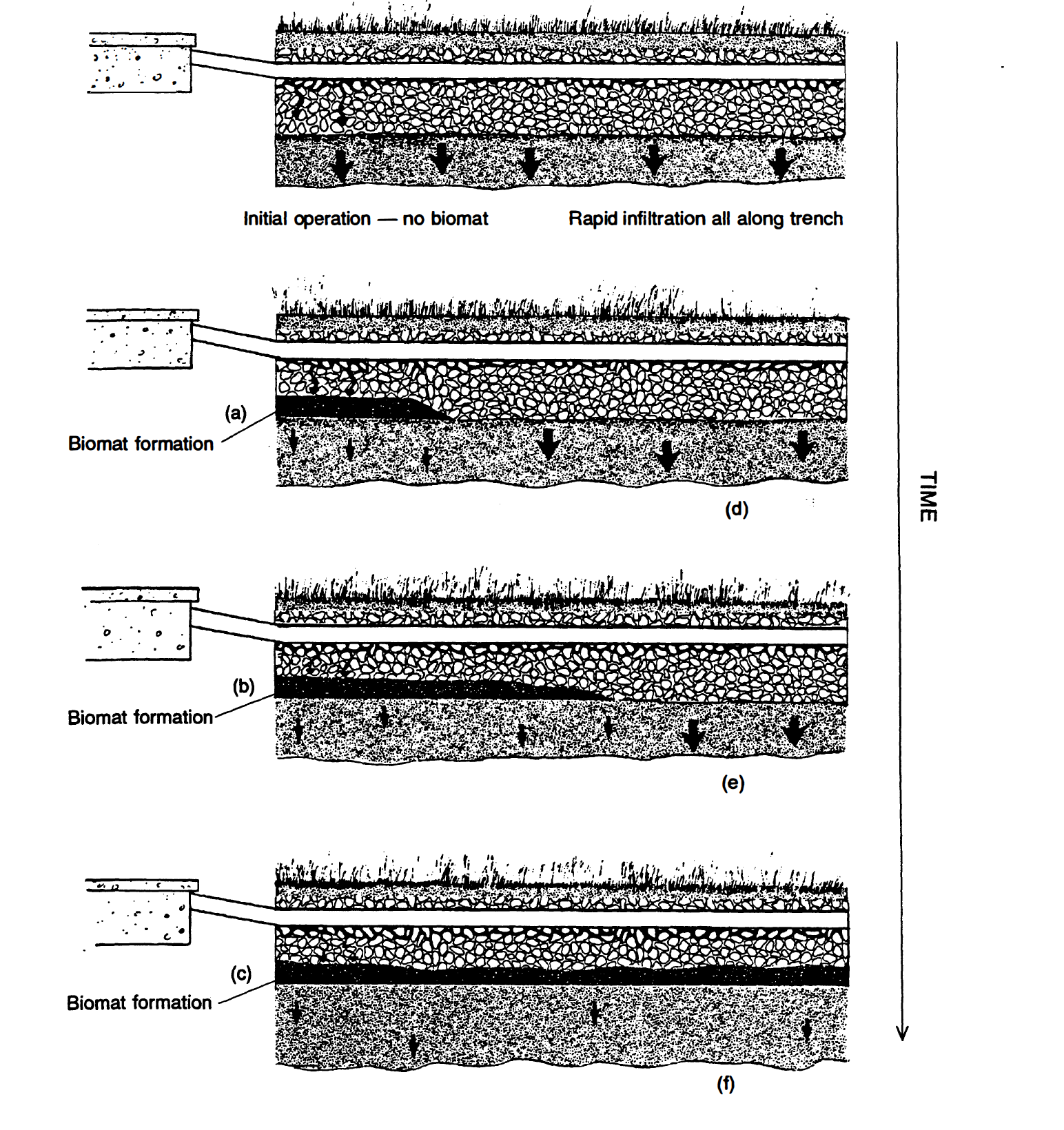The purpose of wastewater treatment is to reduce the pollutants in wastewater that can contaminate ground and surface water systems. Without proper treatment, wastewater can cause public health problems because of the potential spread of bacteria and viruses and can cause environmental degradation and contamination. Wastewater contains bacteria, viruses, nitrogen compounds, and toxic organic compounds which can cause disease in humans. Chemical constituents in wastewater that can adversely affect the environment are oxygen-demanding substances, nitrogen, phosphorus, chloride, sulfate, sodium, heavy metals, toxic organic compounds, detergent surfactants, and suspended solids.
In most on-site systems, the soil is used to treat and dispose of wastewater. Depending on a number of factors, the soil can remove or reduce these pollutants. This section describes the process of wastewater treatment in soils. The health and environmental impacts of the constituents that are released from on-site systems are also discussed in this section.
Treatment Processes In the Soil
Most of the organic solids in domestic sewage are removed by settling that takes place in the septic tank. Some of the solids will partially biodegrade in the tank. Wastewater that leaves the septic tank and enters the soil receives most of its treatment in the unsaturated aerobic regions under the treatment and disposal field.
Wastewater treatment in the soil can be broken down into three different types of processes: physica chemica and biological. Table 4.1.1 describes these processes.
Physical processes include soil filtration, sedimentation in the soil profile, dispersion, and dilution.
Chemical processes involve cation exchange, adsorption, organic residue complex formation, and precipitation.
Biological processes consist of biological oxidation, nitrification, denitrification and plant uptake, inactivation, immobilization, and predation.
All of these processes may occur independently or together for any given wastewater constituent.
Aerobic Treatment
The most rapid treatment of wastewater occurs in an aerobic soil environment, where oxygen is present in the soil. Oxygen allows aerobic bacteria and other microorganisms to feed on the wastewater and break down the contaminants to simpler and less-harmful products. Because oxygen is a very powerful chemical, aerobic degradation proceeds much faster than similar anaerobic processes that occur in the absence of oxygen. The faster aerobic processes help increase the amount of treatment the wastewater receives before the wastewater enters ground or surface water.
Aerobic conditions promote rapid die-off of some pathogenic, or diseasecausing, bacteria that require anaerobic conditions to live.
Additionally, oxygen in the soil favors the growth of aerobic bacteria and microorganisms over the anaerobic organisms. In some instances, aerobic organisms may feed on the anaerobic populations, further reducing pathogen numbers.
Wastewater Treatment Processes in Soils
Biomat
A significant degree of treatment occurs at the biomat in the treatment and disposal trenches. The biomat is a biologically active layer that covers the bottom and sides of the trenches. It is formed from complex bacterial polysaccharides and accumulated organic substances as a result of wastewater moving through the trench into the surrounding soil. A biomat is vital in obtaining a high degree of treatment of the wastewater and to preventing pollution of ground water. However, biomats slow the flow of wastewater into the soil and may even clog the soil surface so that the trench can no longer absorb any wastewater. Figure 4.1.1 shows biomat formation.
Figure 4.1.1 Blomat formation over time. Blomat forms first at beginning of trench and progresses along the entire trench over time.
Biomat Formation Over Time
The following process describes biomat formation over time.
Initially, when the soil absorption system begins operation, there is no biomat present in the trench. The rate of wastewater flow out of the trench is determined by the soil.
As the on-site system is used, the biomat first forms in the trenches where the wastewater enters. Over time the biomat progresses down the trench to eventually cover the entire length of the trench.
The formation of the biomat begins immediately but talces from three to eight years to form completely. The amount of time that it takes to form the biomat depends on a number of factors, including the hydraulic loading rate of the trench, the dosing schedule, the types of substances in the wastewater, and the temperature. The upper portion of the biomat is anaerobic; the lower portion of the biomat grades from anaerobic at its top to aerobic at its bottom because the soil conditions below are aerobic.
Once formed, the biomat physically, biologically, and chemically removes or reduces many wastewater constituents. Further, it limits the rate that water can move into the soil, helping in the purification process because the microbes have more time to treat the sewage.
Because the biomat limits flow from the system into the soil, the amount of wastewater loaded into the system can be no greater than the amount of wastewater that can move through the biomat into the soil. When the amount of wastewater entering the system is the same or less than the amount of wastewater exiting through the biomat and into the soil, the on-site system is considered to be at equilibrium.
A mature biomat is generally in equilibrium: the addition of organic matter to the mat occurs at the same rate as degradation of the organic matter by soil organisms.
From the North Carolina Onsite Guidance Manual


